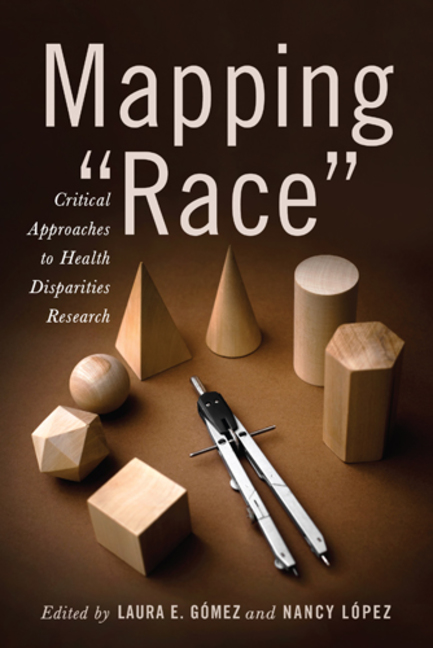Mapping “Race”: Critical Approaches to Health Disparities ResearchPosted in Anthologies, Books, Health/Medicine/Genetics, Media Archive, Social Science, United States on 2013-09-01 02:10Z by Steven |
Mapping “Race”: Critical Approaches to Health Disparities Research
Rutgers University Press
2013-08-12
256 pages
6 figures, 8 tables, 6 x 9
Paper ISBN: 978-0-8135-6136-3
Cloth ISBN: 978-0-8135-6137-0
Ebook ISBN: 978-0-8135-6138-7
Edited by:
Laura E. Gómez, Professor of Law, Sociology, and Chicano Studies
University of California, Los Angeles
Nancy López, Associate Professor of Sociology
University of New Mexico
Forward by:
R. Burciaga Valdez
Researchers commonly ask subjects to self-identify their race from a menu of preestablished options. Yet if race is a multidimensional, multilevel social construction, this has profound methodological implications for the sciences and social sciences. Race must inform how we design large-scale data collection and how scientists utilize race in the context of specific research questions. This landmark collection argues for the recognition of those implications for research and suggests ways in which they may be integrated into future scientific endeavors. It concludes on a prescriptive note, providing an arsenal of multidisciplinary, conceptual, and methodological tools for studying race specifically within the context of health inequalities.
Table of Contents
- List of Figures and Tables
- Foreword by R. Burciaga Valdez
- Preface
- 1. Introduction: Taking the Social Construction of Race Seriously in Health Disparities Research / Laura E. Gómez
- Part I: Charting the Problem
- 2. The Politics of Framing Health Disparities: Markets and Justice / Jonathan Kahn
- 3. Looking at the World through “Race”-Colored Glasses: The Fallacy of Ascertainment Bias in Biomedical Research and Practice / Joseph L. Graves Jr.
- 4. Ethical Dilemmas in Statistical Practice: The Probelm of Race in Biomedicine / Jay S. Kaufman
- 5. A Holistic Alternative to Current Survey Research Approaches to Race / John A . Garcia
- Part II: Navigating Diverse Empirical Settings
- 6. Organizational Practice and Social Constraints: Problems of Racial Identity Data Collection in Cancer Care and Research / Simon J. Craddock Lee
- 7. Lessons from Political Science: Health Status and Improving How We Study Race / Gabriel R. Sanchez and Vickie D. Ybarra
- 8. Advancing Asian American Mental Health Research by Enhancing Racial Identity Measures / Derek Kenji Iwamoto, Mai M. Kindaichi, and Matthew Miller
- Part III. Surveying Solutions
- 9. Representing the Multidimensionality of Race in Survey Research / Allya Saperstein
- 10. How Racial-Group Comparisons Create Misinformation in Depression Research: Using Racial Identity Theory to Conceptualize Health Disparities / Janet E. Helms and Ethan H. Mereish
- 11. Jedi Public Health: Leveraging Contingencies of Social Identity to Grasp and Eliminiate Racial Health Inequality / Arline T. Geronimus
- 12. Contextualizing Lived Race-Gender and the Racialized-Gendered Social Determinants of Health / Nancy López
- Notes on Contributors
- Index
